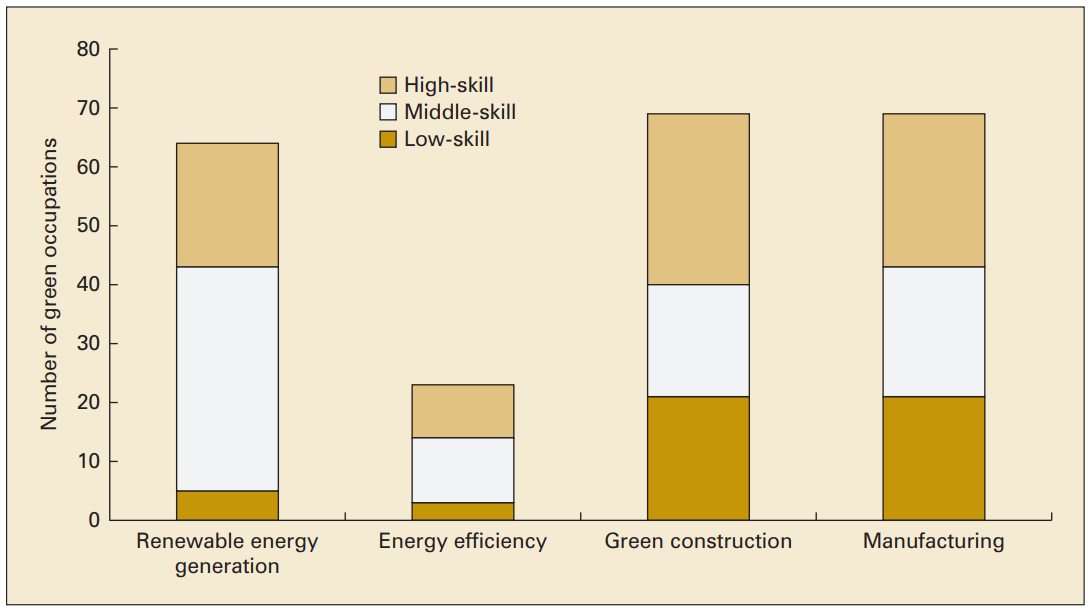3.1 Employment Growth
This domain covers strategies with the outcome of increasing the employment rate for the resident population, such as job training. While this strategy domain generally is not restricted to “green” strategies and can include employment strategies that provide broad economic benefits to Stockton, this report ultimately will focus on “green jobs” in particular. In addition, any strategies that increase employment opportunity and employment wages can increase the purchasing power of households, enabling them to invest in many of the other GHG reduction strategies considered in this report.
3.1.1 Provide training and coaching for low-income workers, rather than unemployed workers

Source: WEF
| Location | Dayton, OH |
|---|---|
| Details | The Workforce Advancement and Support Center (WASC) offered participating workers intensive employment retention and advancement services, including career coaching and access to skills training. It also offered them easier access to work support, in an effort to increase their incomes in the short run and help stabilize their employment. The program was found to be most effective in cities with the lowest baseline of work support. |
| Links | Strategies to Help Low-Wage Workers Advance |
| Implementation Costs & Impact Factor | Based on a New York City program, start-up costs of $615,000 plus three years of $1.85 million each. Bridgeport and Dayton experienced 16% increased participation in education and training. Dayton experienced 8% increase in earnings by Year 3. |
| Scalable Potential | Stockton’s Economic Development Department could operate a similar program. |
| Similar | San Diego, CA Bridgeport, CT |
3.1.2 Provide green-oriented job training and education pathways

Source: RichmondBUILD
| Location | Richmond, CA |
|---|---|
| Details | The construction component of Richmond BUILD’s main track is a pre-apprenticeship program. About 25% of the program’s placements have been into formal building trades apprenticeship programs. Furthermore, after the completion of the 15-week training program, Richmond BUILD partners with employers to provide on-the-job training, funding half of graduates’ wages for a probationary period of 12 weeks. |
| Links | Making Green Work |
| Implementation Costs & Impact Factor | Richmond BUILD spends between $5,000 and $6,000 per student and yielded a 90% job placement rate (average starting wage rate at $15/hr). 30% of participants have a history with the legal system, and there are 35 available seats in each class. |
| Scalable Potential | See Chapter 4. |
| Similar | CDTech Green Corps, Los Angeles, CA East Los Angeles Skills Center Los Angeles Trade-Technical College Oakland Green Jobs Corps JobTrain, Menlo Park, CA Green Jobs Boston Win-Win, New York City, NY |
3.1.3 Create a scholarship fund for students wishing to pursue eco-conscious careers

Number of green occupations, by green sector and skill level. Source: Urban Institute
| Location | N/A |
|---|---|
| Details | San Joaquin Delta Community College does not require that you have a GED or High School diploma to attend. However, if you do not have a GED/High School Diploma, you are not eligible for federally funded student aid. Tuition is $46.00 per unit, which may represent a barrier for some students. If a fund were created that did not require GED/High School Diploma eligibility for financial aid and was targeted towards those pursuing environmentally-oriented careers, then it would incentivize more to pursue those careers. |
| Links | Low-Skill Workers’ Access to Quality Green Jobs |
| Implementation Costs & Impact Factor | Contingent upon demand for eco-conscious jobs |
| Scalable Potential | San Joaquin Delta College or Stockton Scholars could explore this idea. |
3.1.4 Offer continued training and support post-employment

Source: National Service
| Location | New York City, NY |
|---|---|
| Details | WorkAdvance is a sector-based workforce development model that continues training and support post-employment. The developers of the program focused on sectors with strong demand for entry-level and middle-skill employees and relatively short training time. For this program, they focused on transportation & manufacturing, IT, environmental remediation, and healthcare. The program itself has five components including: (1) Intensive screening of program applicants for motivation and readiness; (2) Sector appropriate pre-employment and career readiness, including orientation to the sector and career advancement coaching; (3) Sector-specific occupational skills training aligned with employer needs and leading to certifications that are in demand in the regional labor market; (4) Sector-specific job development and placement services based on strong relationships with employers; and (5) Post-employment retention and advancement services, including ongoing contact, coaching, skills training, and rapid reemployment help if needed. |
| Links | MRDC Policy Brief |
| Implementation Costs & Impact Factor | See table. |
| Scalable Potential | According to the 2013-2017 ACS, the number of Stockton residents that are high school graduates and possess a GED or have less than a high school education is over 75,000. |
| Similar | Towards Employment, Cleveland, OH Madison Strategies Group, Tulsa, OK |